Flying up front is an aspiration for nearly every traveler: there’s better service, you have more space and hopefully you can enjoy some peace and quiet. But if you’re traveling with young kids, it can introduce some headaches: car seats in First Class and Business Class can pose some unique problems despite the extra space.
In this article I’ll cover some important things to look out for as you consider taking a car seat in Business Class or First Class, premium cabin car seat policies for several major airlines and tips to manage.
I reached out to our family travel community for real-world photos to use in this article to show successful car seat use in premium aircraft cabins and I was surprised (but kind of not surprised at the same time) by what I received. Nearly every photo showed mis-use that would not be approved by the FAA or manufacturers based on how airplane car seat testing is performed. That tells me that many parents want to do the right thing by flying with a car seat, but they and the flight crews may not be as informed as they need to be for these unique situations.
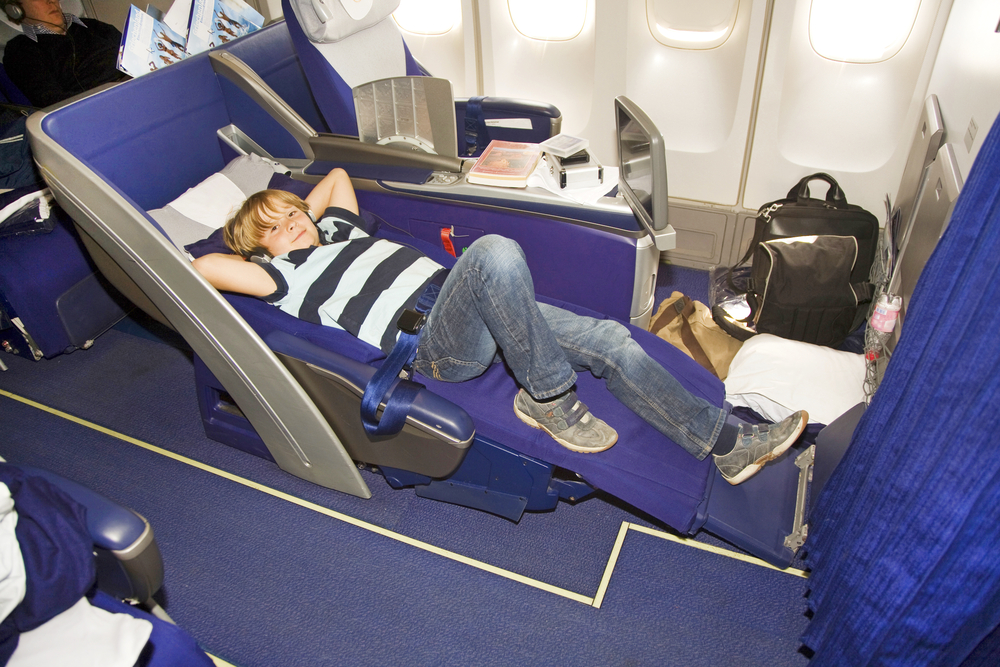
Table of Contents
Potential challenges of taking a car seat in First Class or Business Class
There are a few potential issues with using a carseat in First Class or Business Class. In the US, where your ability to use a car seat on a plane is protected by FAA regulations, the problems come down to whether or not specific configurations have been successfully tested with child car seats. Yes, car seats are tested for use on planes! They must pass an inversion test rather than the crash test for in-car approval.
In other countries, there’s no government-enforced right to use a car seat so every airline establishes their own policies. In some cases they simply don’t want kids young enough for car seats flying up front. BOOOOO!
Read more: Best lightweight convertible car seats for travel
As you examine the premium seating configuration of your upcoming or potential flight (I recommend checking out SeatGuru with the specific flight number and date), here are some things to look out for:
Angled or backward-facing seats
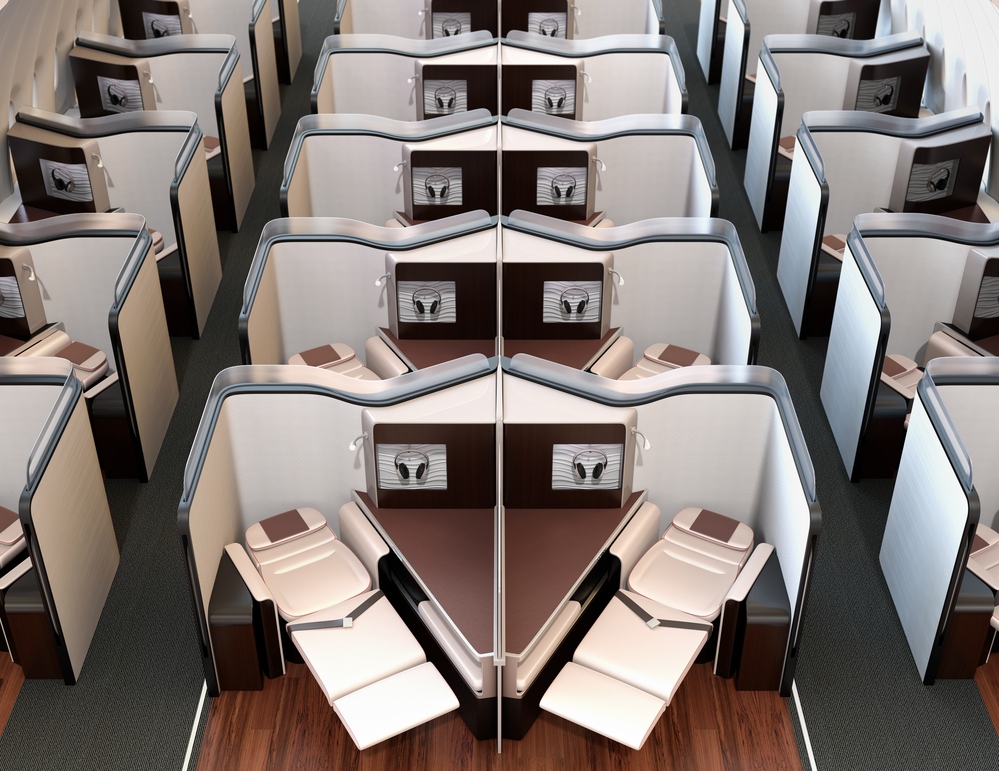
Many premium cabins these days feature angled or backward-facing seats to offer passengers more privacy, often in suite-style arrangements. These can’t be used with car seats if the angle of the seats exceeds 18 degrees (including backward-facing seats).
Where things get sticky is that some premium cabins have a mix of forward-facing seats, angled seats and backward-facing seats. In theory a forward facing seat in that cabin should be allowed to host a car seat. But read on for more potential problems with that configuration.
Lap-shoulder seat belts
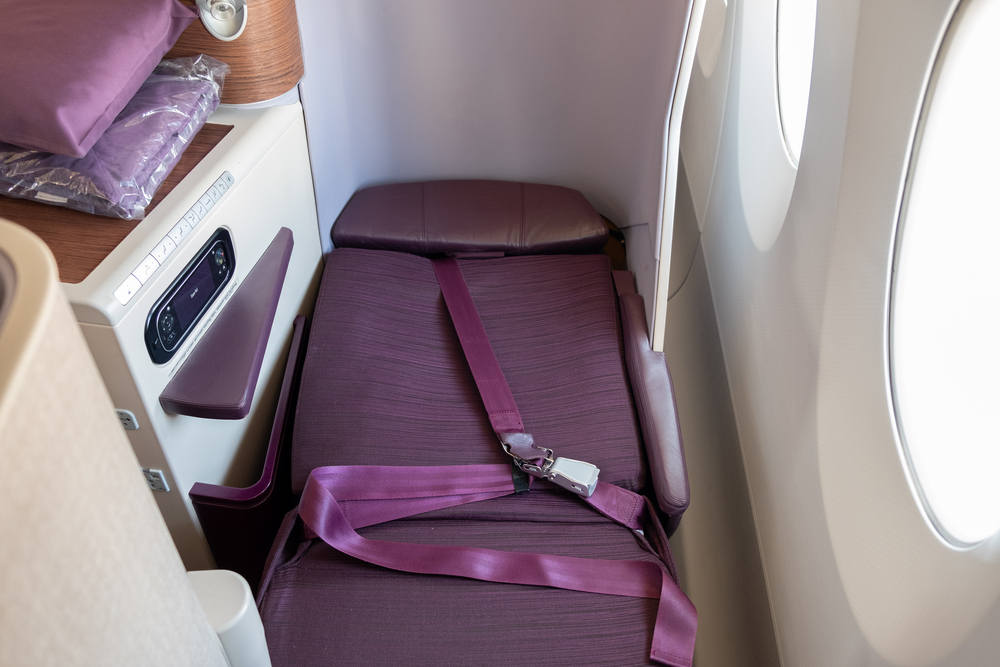
To keep passengers safe in these angled seats, the FAA requires some extra modifications. One of those options aircraft manufacturers can use is a lap-shoulder seatbelt similar to those found in cars rather than the simple lap-only seatbelts used on forward-facing aircraft seats. The other benefit of these belts is that they allow passengers to recline during take-off and landing.
While those lap-shoulder belts should theoretically perform just as well as lap belts (if not better), car seats haven’t been inversion tested in that configuration. Therefore, car seats are not technically approved to use in those seats if the shoulder portion is attached.
You should be able to detach the shoulder portion of the belt (which is only required for adult passengers during takeoff, landing and taxi). In that case, you can keep the seat upright and install as usual.
Inflatable seat belts
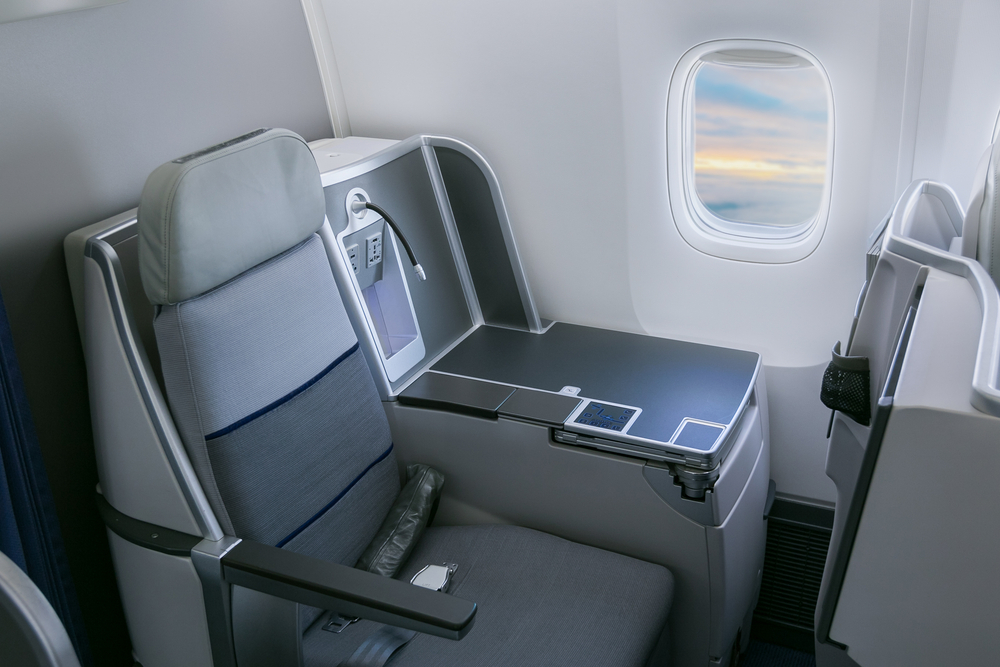
Many premium aircraft seats are now equipped with airbags in the seatbelts to prevent passenger head and neck injuries in severe accidents. On their own, you can’t install car seats with airplane inflatable seatbelts.
Fortunately, aircraft inflatable seat belts are sometimes a solvable problem. Using a seatbelt extender (provided by the flight crew) will deactivate the seatbelt airbag and render the seatbelt safe for car seat installation.
Important: A seatbelt extender may introduce too much length for a good baseless installation with an infant car seat or another seat with a relatively short belt path. If you plan to book a seat with an inflatable seatbelt and use a seatbelt extender, you may want to bring a travel convertible car seat instead. Better yet, avoid these seats and stick with Premium Economy. You can also consider contacting your local Ford dealership for a “locking clip” (because theirs are actually “belt shortening clips”… but be sure you know how to use one correctly).
By the way, inflatable seatbelts aren’t recommended with lap babies due to safety concerns.
Car seats in lie-flat seats
One of the big draws of business class and first class these days is the huge lie-flat seats. They’re great for adults and big kids to stretch out and get some sleep! Barring any of the other issues raised in this section, there’s no inherent problem with installing a car seat on a lie-flat seat.
One creative mis-uses I’ve seen from a few parents, however, is installing their child’s car seat forward facing on a lie-flat seat and then reclining it way back for the kiddo to get some sleep. Car seats are tested on standard economy seats that have just the standard recline available – around 5 degrees, versus up to 180 for lie-flat seats up front.
Reclining the airplane seat changes the tension on the seatbelt so that it may no longer be within test parameters. Furthermore, car seats just haven’t been tested in that configuration so there’s no way to know if a child would fare ok or would be at greater risk in a survivable crash.
So feel free to install your car seat on a lie-flat seat (assuming there’s no shoulder belt or airbag) but keep the seat fairly upright as it would be in the cheap seats. A good example is business class on Emirates, which uses a regular aircraft seatbelt.
“Pod” configurations
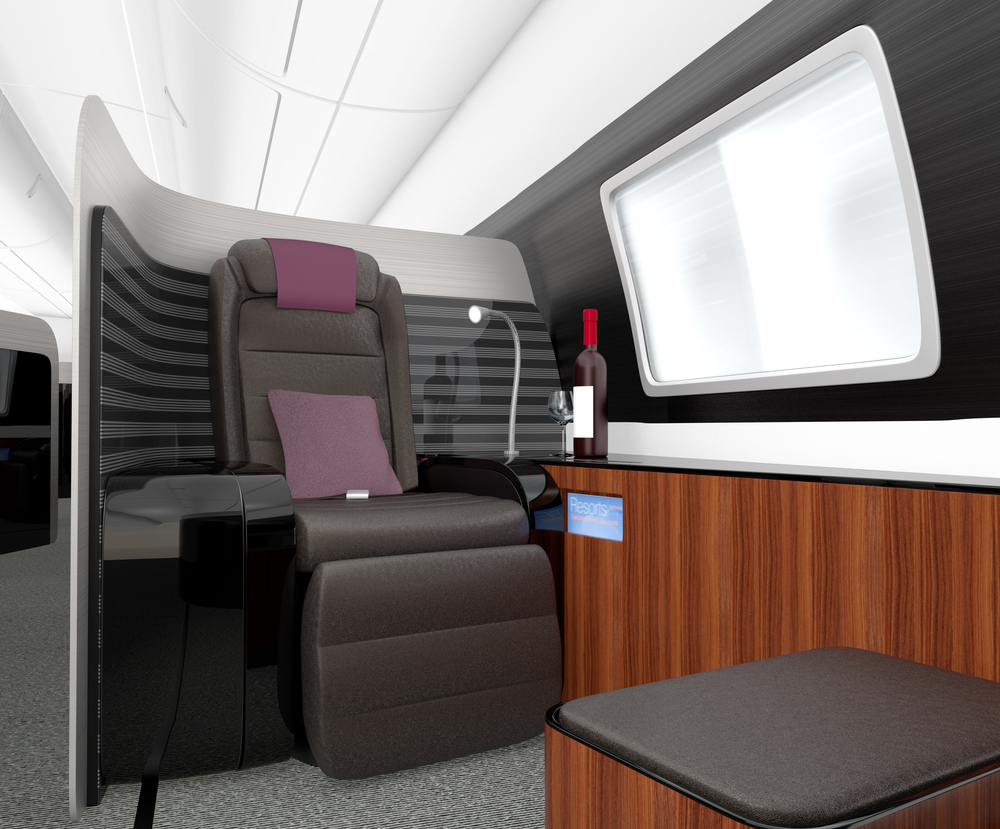
Many premium aircraft cabins now figure private “pod”-style configurations. These are amazing for adult travelers who want a restful flights, but many parents report that their toddlers and young children freaked out due to feeling isolated. Even for kids who can handle not physically seeing their parents, they’ll probably need help approximately 57 times per hour with food, water, tablets, toys, bathroom visits and everything else.
Airline-specific rules about car seats in Business Class and First Class
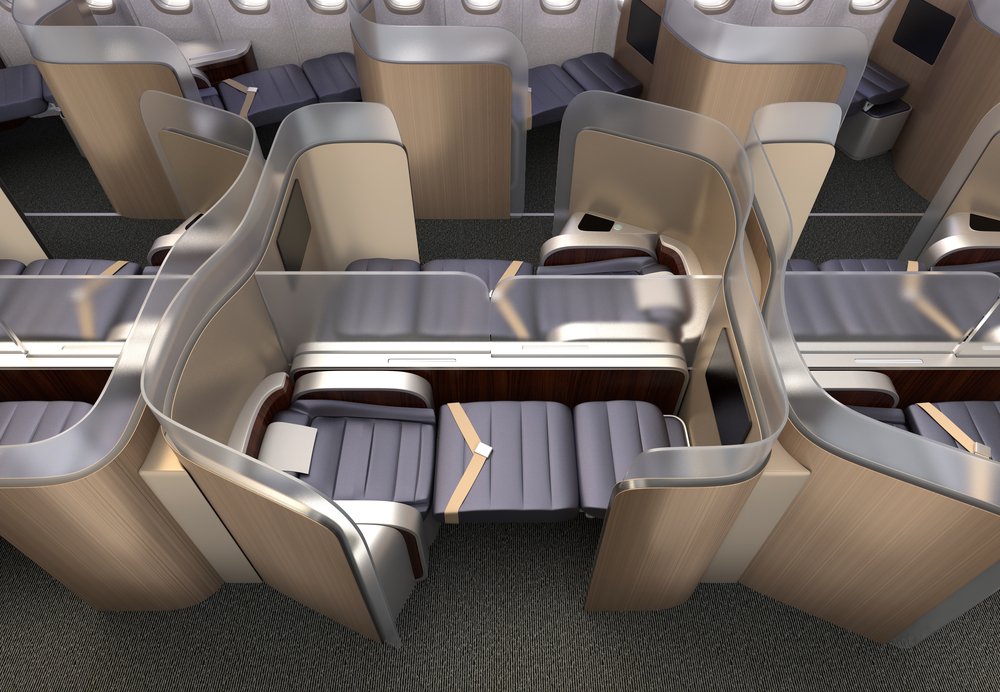
Airline rules about car seats in first class and business class are constantly changing, so be sure to check before you book a flight. In general you’ll find fewer car seat issues on narrow-body planes, as they don’t have the space for angled seats and haven’t usually been upgraded to lap-shoulder seatbelts.
The typical rules still apply as well:
- Car seats can’t block another passenger’s exit (with window being the preferred spot unless you have two car seats next to each other)
- No car seat in an exit row or immediately before/after
Below you’ll find a summary of restrictions at the time of this writing for a few popular airlines. Many international airlines’ websites are thin on information about taking a car seat in first class or business class, but it’s important to remember that features like angled seats aren’t safety-tested with car seats at this time.
Reader Katy K. also pointed out that an equipment swap can move you from a plane with car seat-friendly premium cabins to one in which you can’t use your car seat. That happened to her family on a flight!
United Airlines
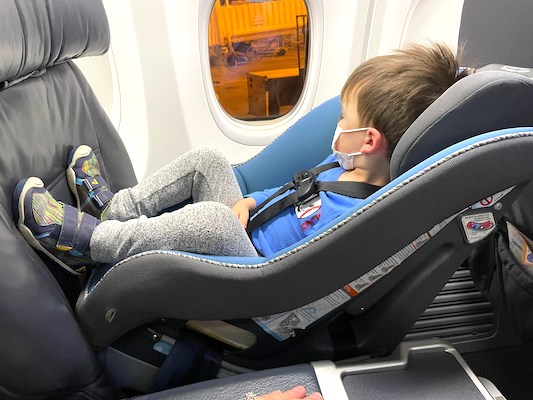
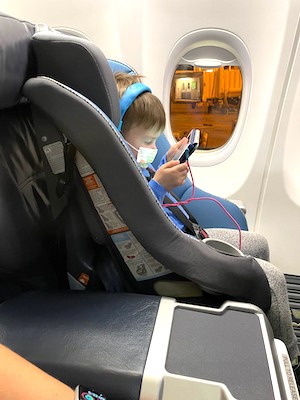
Above you can see the Graco Contender installed in a regular domestic United First Class cabin (thanks to fellow CPST Kendra G.). There was plenty of space for rear facing, but the seat ended up reclined a little too much so she chose to forward face her 3 year old. This little guy rode safe and comfy!
Car seats can’t be used in:
- rear-facing seats
- Polaris business 767, 777, 787
Polaris is truly a wild card. Plenty of families report sometimes being permitted to use a car seat on the forward-facing seats in the cabin, but then on the other leg of the flight they were told that they can’t. Reader Emily J received a ticket that specifically said “no car seats” per United policy, but was assured by customer service reps that she would be allowed to install their Graco 4ever. It allows recline 4 when forward-facing, which is nice and reclined as you can see below. This seat is installed only with the lap portion of the seatbelt in line with Graco’s airplane installation instructions.
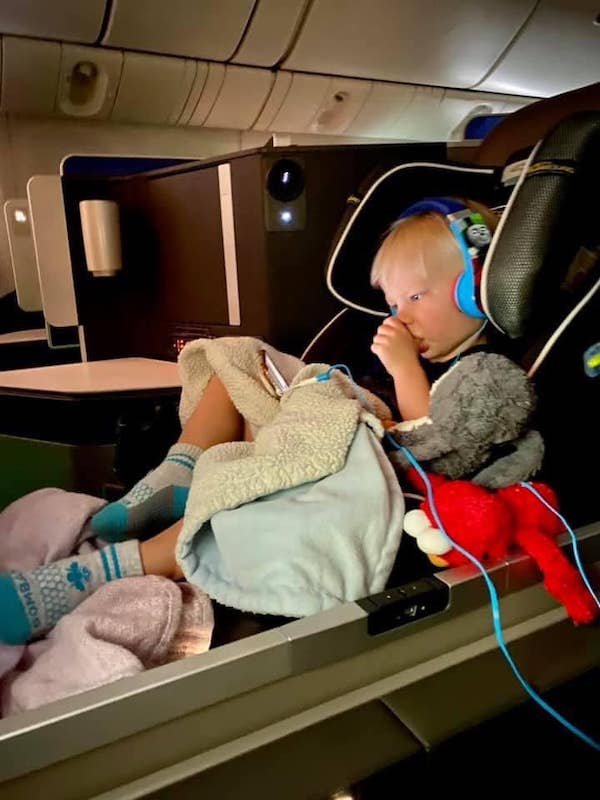
If available, consider booking United Premium Plus with car seats instead. It offers more space than economy for easier installation, though the fixed arm rests can be challenging if you bring a particularly wide seat. But as long as you bring a narrow travel car seat, you’ll enjoy many of the upgraded amenities of business class without the limits on car seat installation.
American Airlines
You’re welcome to use a car seat in American first class on domestic flights. As you can see in reader Kacey’s photo below, the Doona car seat worked perfectly. These are pretty standard seats: they all face forward, have lap-only seat belts without airbags, no lie-flat ability and plenty of width to install the car seat of your choosing.
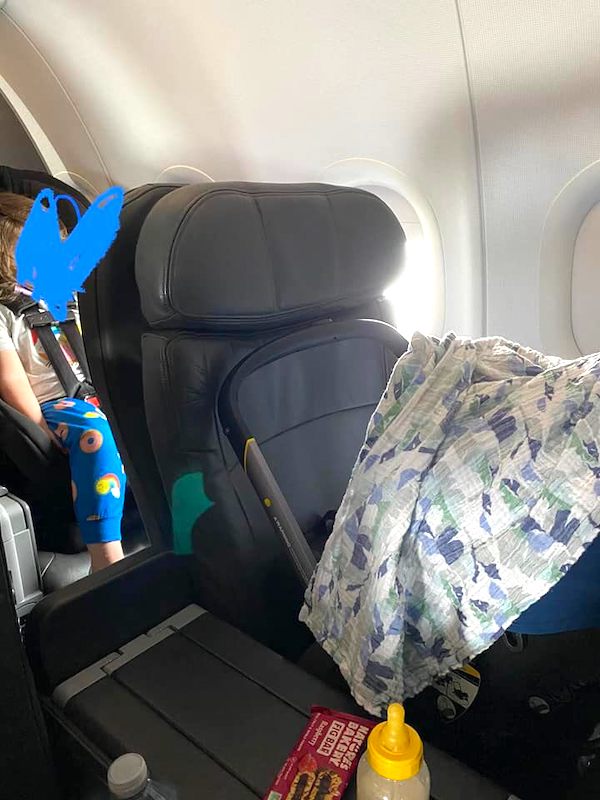
Car seats can’t be used in:
- First class:
- A321T
- Business class:
- Boeing 777-200
- Boeing 777-300
- Boeing 787-800
- Boeing 787-900
Consider booking Main Cabin Extra or Premium Economy with car seats instead.
Delta Airlines
Car seats can’t be used in:
- Delta One flat bed seats:
- A330-200
- A330-300
- Boeing 747
- Boeing 757
- Boeing 767
- Boeing 777
Consider booking Delta Comfort+ with car seats instead if you’re flying domestic. Reader Lauren used her Baby Trend Trooper in those seats and it worked out great with plenty of space for everyone!
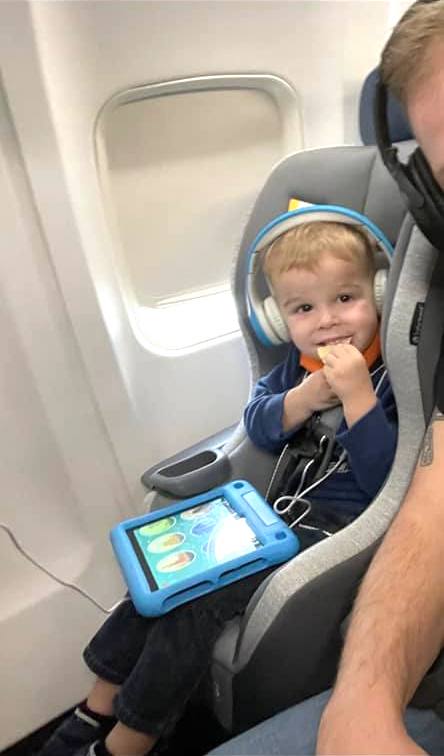
On international flights, you can use a car seat in Delta Premium Select. In that class you’ll get extra space, a bigger screen, an amenity kit, early boarding and more. Check out how spacious it was for reader Kathryn’s family and their Cosco Scenera Next! They booked these seats specifically because you can’t bring a car seat in Delta One.
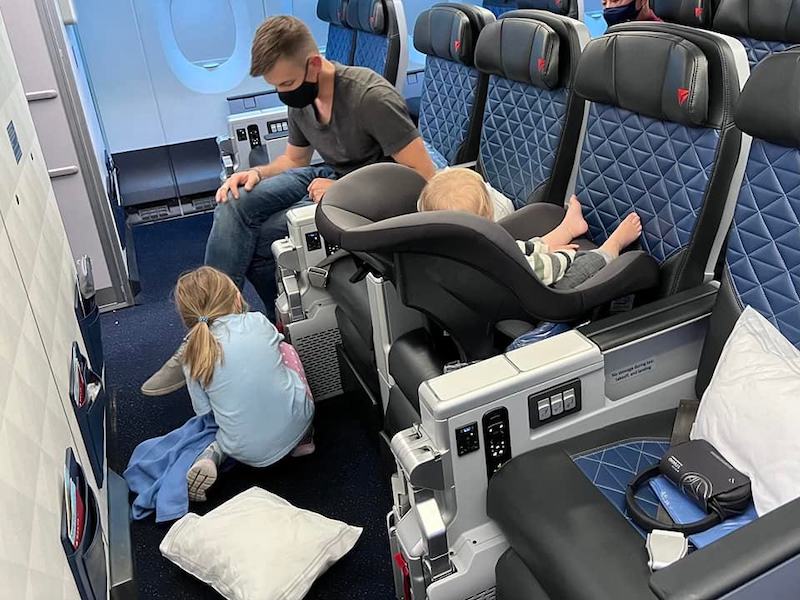
Jet Blue
Jet Blue hasn’t clarified any seating restrictions for the new Mint service on their website, but when I asked them outright they confirmed that you can’t use a car seat in Jet Blue Mint suites (presumably because of the seat angle).
Hawaiian Airlines
Hawaiian Airlines allows car seats in all of their First and Business Class seats. Reader Kacey’s kiddo rode in style all the way to paradise in the Nuna Rava. These seats are slightly angled, but apparently less than the 18 degrees that would be problematic for safe car seat installation.
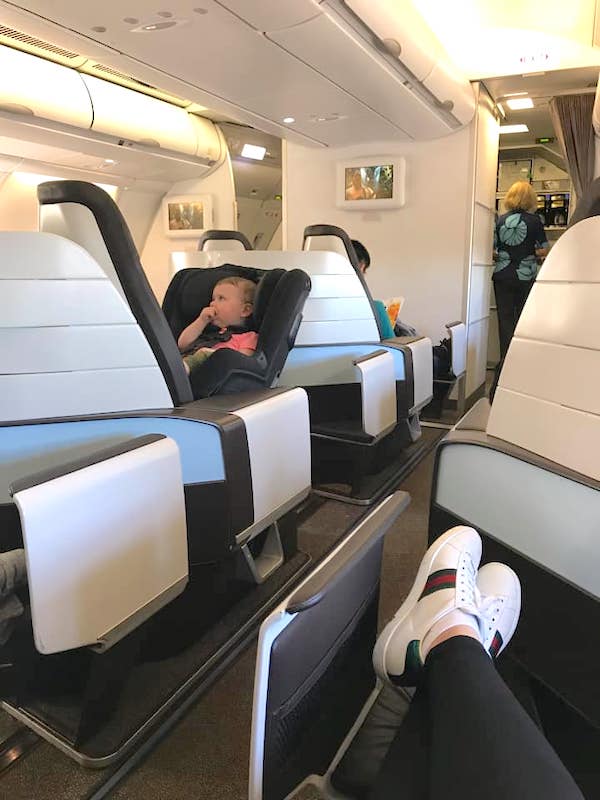
If you opt for Economy instead, note that row 4 of the B717 island-hoppers doesn’t allow car seats despite the absolutely massive leg room.
Lufthansa
If you’re considering flying Lufthansa business class with a car seat, be sure to check the seat map for your specific flight over on SeatGuru – there are many different configurations, and here’s one example.
With the exception of the swanky new Boeing 747-800, you shouldn’t have issues flying Lufthansa first class with car seats. Their other configurations have forward-facing seats with traditional lap seatbelts.
Fortunately Lufthansa offers a very nice Premium Economy cabin on most international flights, and those seats are all forward-facing.
British Airways
Car seats can’t be used in:
- Club World seats
- Boeing 781 First Class
- Boeing 789 First Class
- Boeing 772 First Class
- Boeing 773 First Class
- Boeing 744 First Class
Consider World Traveller Plus with car seats instead. But also… if you have a baby or toddler, consider flying a different airline entirely. British Airways doesn’t permit rear facing car seats at all.
Rear facing is the safest option for children under 2 and many car seats don’t even permit forward facing until kids are over 2 (in addition to meeting both the height and weight requirements). If you plan to fly with an infant car seat for the convenience of popping it in and out of the stroller as you dash around London, British Airways will force you to check your car seat regardless of risk to your child and potential for the seat to be damaged.
Air France
Car seats can’t be used in:
- La Première cabin (all aircraft)
- Boeing 777 Business Class
- Boeing 787 Business Class
- A350 Business Class center seats (window seats face forward and are ok)
Air France has been pretty aggressive about installing seatbelt airbags so keep your eyes peeled. They actually recommend contacting them in advance of your specific flight to discuss seating configurations.
Also of note, while Air France permits rear-facing for take-off and landing, they only allow forward facing during the cruise portion of your flight; if you’re traveling with an infant, bring one of these car seats instead of your infant car seat.
KLM
Car seats can’t be used in:
- Boeing 787-10 World Business
- Boeing 787-9 World Business
Thankfully you can use a car seat in most KLM World Business cabins, as the seats are generally forward-facing or only slightly angled. If your route it only served by the Boeing 787s listed above, consider choosing KLM Economy Comfort with car seats instead.
Cathay Pacific
There are already serious limits on using a car seat on Cathay Pacific: they’re technically only permitted for children up to age 3. Rear-facing is only permitted if it doesn’t impede another passenger’s recline. The also entirely prohibit car seats on some planes, so check closely!
Car seats can’t be used in:
- Boeing 777-300 (non-ER)
- Boeing 777-300 (where airbag seatbelts are installed)
- A330-300 (some configurations)
- A350-900 (where airbag seatbelts are installed)
- A350-1000 (where airbag seatbelts are installed)
The Cathay Pacific car seat policy is so strict because over the last decade they’ve installed seatbelt airbags even on many Economy and Premium Economy seats. While the service is reportedly incredible, if you want to bring your travel car seat on board you may need to be extremely choosy about your specific flight or find a different airline until your child is at least 40lbs and can safely ride without a car seat.
Singapore Airlines
Thankfully the Singapore Airlines car seat policy is crystal clear: any car seat that’s aircraft-approved in the US, Canada, Europe, UK or Aus/NZ is fine for kids three and under.
There are no additional Singapore Airlines business class car seat rules except that your car seat can’t be more than 19″ wide – so some of the widest car seats on the market won’t work but many will. They aren’t going to come by with a tape measure, but you need to be able to fit your seat between the arm rests (which don’t generally move, though configurations vary depending on your route). Most car seats are a little narrower through the bottom and then flare near the shoulders and head so it shouldn’t generally be an issue.
Thai Airways
Thai Airways doesn’t specify any seating restrictions for using a car seat in Royal First or Royal Silk Business; however, many of their premium seats (like on the new A380s) have a lap-shoulder seatbelt that isn’t approved for use with car seats.
That said, Thai Airways car seat policy overall is incredibly restrictive. They only allow car seats up to 2 years old and they require that children be held during take-off and landing. Those are the most dangerous parts of the flight and exactly when using a car seat confers the greatest safety benefit.
Should you fly in Business Class or First Class with kids?
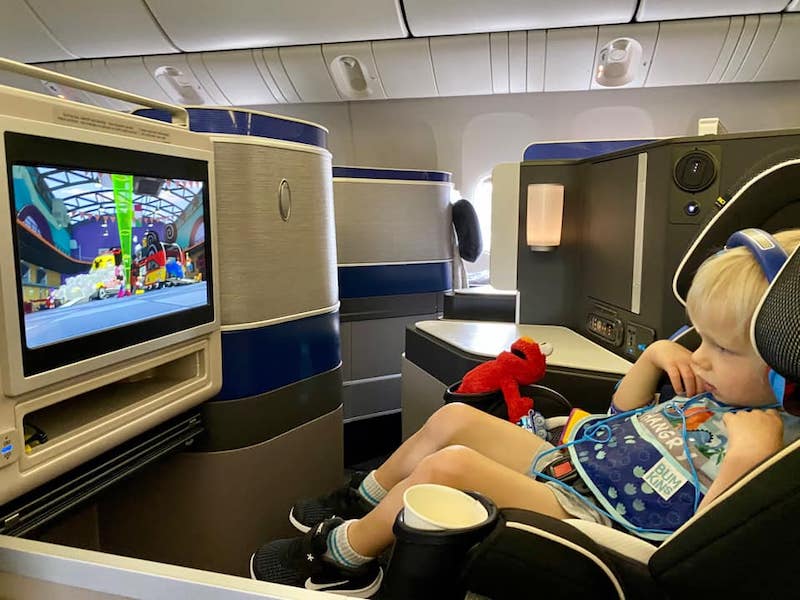
Every family’s choice on flying with kids in First Class or Business Class will be different. Below are some considerations you may want to keep in mind.
If your child weighs more than 40lbs: Kids over ~40lbs (it varies a little by plane) can ride pretty safely with the airplane seatbelt on its own. To avoid checking a car seat, take one of these foldable car seats on board as a carry on.
If your child weighs less than 40lbs: Kids under 40lbs may not fill out an airplane seatbelt well enough to stay safe during a runway incident or severe turbulence. You’ll be better off booking Premium Economy (if available) for everyone and bringing the car seat on board. That’ll keep your child safe and avoid damage to the car seat.
Read more: Best travel car seats for every age
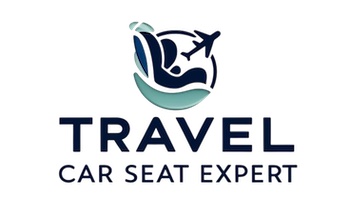
Any insights on Singapore Airlines Business Class?
Hi Sonja,
Thanks for stopping by and great question! Singapore doesn’t specify any restrictions on car seat usage in Business Class for children under 3 and the seats look like they’re forward-facing with normal seatbelts. In fact, their website even specifies that you can use seats up to 19″ wide in Business Class!
If your child happens to be over 3 but under ~50lbs (those seats are harder to fit a child body than smaller economy seats) I’d bring the car seat anyway and just say your child turns 3 the next week 😉
Safe travels,
Melissa
It looks like Singapore Air 777s have airbag seat belts, but nothing indicates that you can’t use a car seat there. Someone mentioned that they can disable the airbag. Have you heard of disabling the airbag?
Hi Amanda,
Thanks for stopping by! Generally seatbelt airbags are disabled by attaching an extender. The challenge is that sometimes you can’t get a safe installation when you do that, as the airbag part is too bulky for some belt paths and its fixed length makes it hit in the “wrong” spot. You might be able to get away with it on some car seats that have an especially high or wide belt path.
Safe travels,
Melissa
Anything for Iberia?
Hi Emily,
Thanks for stopping by! It looks like Iberia’s first class seats are not angled and just have a standard aircraft lap belt. You should be able to use a car seat in Iberia first class (or business class) at this time.
Safe travels,
Melissa